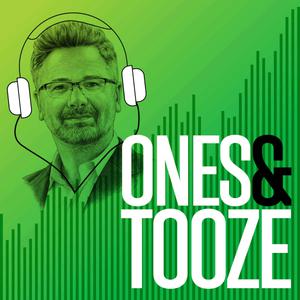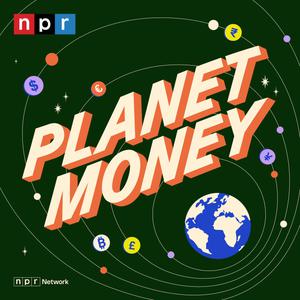
The New Bazaar
Bazaar Audio
A weekly conversation on how the economy shapes our lives
- 56 minutes 2 secondsHigh-skilled Immigration: The Way Ahead to Stay Ahead
On today’s episode, Cardiff chats with his EIG colleagues Adam Ozimek, chief economist, and Connor O’Brien, research analyst, about the one policy that achieves all three of the following goals simultaneously:
- It massively boosts the rate of economic growth through its effects on entrepreneurship, innovation, and the creation of entire new industries.
- It reduces inequality.
- Not only does it cost the taxpayers nothing, it actually saves them huge sums of money.
That policy is the expansion of high-skilled immigration, a subject that became a source of contentious debate within the American right not long after the 2024 election. As it happens, Adam and Connor are the co-authors (with John Lettieri) of a big new report, Exceptional by Design, which explains how to design a high-skilled immigration that will maximize its benefits for American workers, businesses, and communities.
In this chat, the three discuss:
- How bad thinking has led to bad policy
- The surprisingly nuanced economics of high-skilled immigration
- Three myths about high-skilled immigration
- The flaws in the current system
- A new policy vision to change it
The three close with a discussion of why high-skilled immigration carries so much promise for the United States in particular — and the enormous, self-inflicted damage of failing to capitalize on it.
RELATED LINK
- Exceptional by Design, by Adam Ozimek, Connor O’Brien, and John Lettieri
Hosted on Acast. See acast.com/privacy for more information.
31 January 2025, 11:00 am - 53 minutes 25 secondsAI and the Global Battle for Tech Supremacy
It’s not often that someone comes up with a new, provocative, and persuasive theory about the competition between the US and China to be the world’s leading economic and technological superpower. The topic is so salient right now, the source of so much commentary, that it’s hard to say something that hasn’t already been said many, many times.
But this episode’s guest, Jeffrey Ding — a scholar of international relations at the George Washington University and the author of a new book called Technology and the Rise of Great Powers: How Diffusion Shapes Economic Competition — has done just that.
And the short version of Ding’s theory goes like this…
It’s not as important as you might think for a country to be the first one to develop the new technologies of the future. What really matters are two things.
First, that the technologies a country does develop are General Purpose Technologies. These are technologies that make every sector across the economy more productive, more efficient, more innovative. The personal computer and other information technologies, for example, didn’t just make the tech sector more productive. Workers in every industry use computers to be better at their jobs.
And the second thing that matters is that a country be especially good at diffusing, or spreading, those General Purpose Technologies throughout the whole economy, precisely so that those technologies can make everyone more productive.
And as Jeff argues, the US already has big advantages over China on both of these indicators. But why? What makes a country better at technological diffusion? What are the leading contenders for the general purpose technologies of the future? And what policies can a country put in place if it wants to become or remain the world’s dominant economic superpower?
You’ll find answers to those questions and more in this episode’s chat with Jeffrey Ding.
RELATED LINKS:
- Jeffrey’s GitHub page
- Technology and the Rise of Great Powers (Jeffrey’s book)
- ChinAI (Jeffrey’s newsletter about Chinese AI)
- The Illusion of China’s AI Progress (Foreign Affairs essay)
Hosted on Acast. See acast.com/privacy for more information.
19 December 2024, 11:30 am - 48 minutes 10 secondsElection freakouts and American workers
How close is the 2024 presidential election?
Here is how the New York Times framed it recently: “Never in modern presidential campaigns have so many states been so tight this close to Election Day. Polling averages show that all seven battleground states are within the margin of error, meaning the difference between a half-point up and a half-point down — essentially a rounding error — could win or lose the White House.”
A recent Times-Sienna poll has the race between Donald Trump and Kamala Harris deadlocked at 48 to 48. Other polls are similarly close — which does not mean they are all telling the same story. Today’s guest, Kristen Soltis Anderson, writes that although “several of them show a dead heat, beneath the surface, they diverge in how they arrive at that result”.
What stories can we glean from each poll? What theories of this election can we derive from those stories? Are the polls even right? And why, despite verbal gaffes and incendiary rallies and international conflict and general campaign turmoil, have the polling averages remained so steady in recent months?
Kristen is a founding partner of Echelon Insights, an opinion research and analytics firm, and contributing Opinion writer to the New York Times, where she often writes about what is knowable and not knowable based on the polls. We talk about all these themes, including a theory of the election that Kristen came upon while watching football in Phoenix on a Sunday.
Finally, we discuss a detailed survey of American workers that Echelon Insights, Kristen’s firm, put into the field for the Economic Innovation Group — and its most surprising findings.
All this and more on today’s episode!
RELATED LINKS:
Opinion | The Polls Show a Dead Heat, but They Don’t All Tell the Same Story
Opinion | Two Weeks to Go, but Only One Way to Stay Calm
Opinion | This Year’s October Surprise May Be That There Isn’t One
Opinion | Why the Election Is Coming Down to Defining Kamala Harris - The New York Times
Opinion | I’ve Studied the Polls. Here’s Why Harris Isn’t Running Away With It.
The American Worker Project Survey: Key Findings Deck
American workers and the 2024 election
Hosted on Acast. See acast.com/privacy for more information.
1 November 2024, 10:00 am - 1 hour 2 minutesHow to Slay Economic Zombies
What is the right foreign economic policy toward China? Did the Fed cut rates in time to avoid a recession? Have agglomeration economies been changed by work-from-home and the dematerializing economy?
On September 21st, Paul Krugman joined host Cardiff Garcia live on stage for a sweeping conversation at the #EconTwitterIRL conference in Lancaster, Pennsylvania.
They discussed not only Paul’s view of the economy and his achievements in economics, but also his approach to communicating his ideas about economics — which is likely to be as important a part of Paul’s legacy as the (Nobel prize winning) economics itself.
Among the other topics they covered:
- Paul’s hippie-punching days in the 1990s
- How economic geography has changed through the decades
- Whether place-based policy works
- Why a previous regret no longer bothers him much
- How Paul blends style and substance in his writing
- Why Democrats seem so bad at running big cities
- The work Paul is most proud of
And at the end of this fun, dense, and surprisingly humorous chat, you’ll hear Paul answer the questions he fielded from the audience of economists, journalists, think tankers and others in attendance.
RELATED LINKS:
Hosted on Acast. See acast.com/privacy for more information.
9 October 2024, 1:43 pm - 38 minutes 27 secondsIs the Introvert Economy here to stay?
"The introverts have taken over the US economy."
That's the provocative title of a recent Bloomberg column from economist Allison Schrager. As she looked into the data on how Americans have been spending their time since the pandemic, she noticed that they are spending less time socializing with their friends on weekends and more time in front of screens. Even when they do go out, it's increasingly for an early dinner. That's all in addition to the bigger share of Americans who now work remotely, a trend that accelerated during the pandemic and is unlikely to ever fully reverse.
Who are the winners and losers from these trends? And what's going on?
Obvious explanations include pandemic experimentation, smartphones, better entertainment and telecommunications technologies. But Allison also likes to see these trends through the prism of risk. She tells Cardiff that the "risk-free rate" that Americans can earn from indoor, introverted activity has climbed. With so much choice over the movies, music, and books you can consume in your home, not to mention access to social media and swipe-able dating apps, you are guaranteed to have at least a pretty good time by staying in. Going out means making an "investment" with possibly more upside (meet the love of your life, see a memorable live performance, attend an epic party) but also a vastly more uncertain payoff.
Allison and Cardiff discuss these ideas and whether the economy's new introvert-friendliness is likely to stay. They also talk about other trends that could soon favor extroverts, the risks of AI and automation in the labor market, and the skills and traits that will matter for the jobs of the future.
Related links:
- The Introverts Have Taken Over the US Economy (Bloomberg column)
- Known Unknowns (Allison's newsletter)
- An Economist Walks Into a Brothel (Allison's book about risk)
Hosted on Acast. See acast.com/privacy for more information.
29 March 2024, 4:30 am - 55 minutes 58 secondsImmigration and the border: the real story
When people talk about the crisis at the border between the US and Mexico, what specifically are they referring to?
The Department of Homeland Security keeps track of a statistic called “border encounters” at the US border with Mexico. This includes primarily the large number of people who try to cross the border without documentation, or illegally, and aren't crossing at a formal port of entry. It also includes people who do try to cross the border at a port of entry but who are then found not eligible to be admitted into the US.
In the past three years, under the Biden administration, the number of these border encounters each year has been more than quadruple the average of what it was throughout most of the previous decade, under the Trump and Obama administrations.
The system for processing all these migrants has been entirely overwhelmed. And if you’re a politician or a pundit or someone else pushing an agenda, the temptation is to make it political. To argue that this is either all Joe Biden’s fault for being "too soft" on immigration, or the fault of Donald Trump for not fixing the problem sooner, or Congress for refusing to collaborate on a bill that would address the issue.
Today’s guest does something different altogether. Andrew Selee is the head of the Migration Policy Institute, or MPI, which is the think tank Cardiff turns to when he wants factual, nonpartisan, non-stupid commentary on immigration—but especially when he just wants to inform himself on the topic outside the nonsense of how debates on immigration tend to play out in public.
So Cardiff speaks with Andrew about the real, fundamental reasons behind the crisis at the border, and what can be done about it.
They also talk about legal immigration, which despite many problems has actually been a kind of quiet success of recent years.
Other topics they discuss include the two eras of border management, the multi-layered effects of the pandemic on immigration, and a new idea for how to reform immigration to become more responsive to the needs of the US labor market.
Related links:
- Biden at the Three-Year Mark
- Shifting Realities at the U.S.-Mexico Border
- Migration at the U.S.-Mexico Border: A Challenge Decades in the Making
- A New Way Forward for Employment-Based Immigration: The Bridge Visa
Hosted on Acast. See acast.com/privacy for more information.
10 March 2024, 10:00 am - 53 minutes 35 secondsIf econs could hoop
Who is the Magic Johnson of economics? Who was the Adam Smith of basketball?
On this fun and oddball episode of The New Bazaar, Cardiff speaks with Tyler Cowen, economist and author of GOAT: Who is the Greatest Economist of all Time and Why Does it Matter?
Inspired by the sportswriter Bill Simmons, Tyler wrote his book from the standpoint of a fan—having fun, taking sides, admitting biases, unapologetically trying to entertain the reader instead of presenting sober (boring) analysis.
Cardiff and Tyler—both huge basketball fans—first discuss Tyler's ranking of the great economists and his lament for what economics used to be. Tyler also gives his reasons for releasing the book as a ChatGPT trained on its text, the first such book of its kind.
Then begins the fun. They take turns finding analogs for the great economists from the history of the NBA. And they do the same in reverse for basketball's own GOATs. Which economist changed the nature of the field similar to the way Steph Curry set off the three-point revolution? Is there an economist whose comprehensive genius rivaled the ability of LeBron James to engineer exactly the outcome he wants on the court? What basketball player matched the charisma, brilliance, and even investment success of Keynes?
And why does Cardiff argue that Tyler himself is the Charles Barkley of economists despite their differences in personality, size, and other obvious dimensions?
All throughout the chat, Tyler and Cardiff are exploring the common traits that define greatness in both hoops, the social sciences, and perhaps other domains. A treat for fans of either economics or hoops, or who simply enjoy the virtues of fandom itself.
Related links:
Hosted on Acast. See acast.com/privacy for more information.
31 January 2024, 5:04 am - 1 hour 37 secondsHoop dreams of electric sheep
Seth Stephens-Davidowitz has unusually written an unusual book.
The data analysis included in "Who Makes the NBA?: Data-Driven Answers to Basketball's Biggest Questions" normally would have taken Seth, a trained economist, multiple years of writing and running code. But because of new artificial intelligence tools, he finished the book in just thirty days. And he used AI tools not just for the coding, but also for the artwork, copy editing, and even to write the appendix.
He discusses with Cardiff the lessons he learned about using AI, and what such accelerated productivity might mean for the future of the labor market.
Then they discuss the actual findings in the book, an investigation into the backgrounds of the basketball players who make it to the NBA and succeed when they get there. How much of success is genetic? What accounts for the NBA's market failures—the traits of players who get paid too much and too little relative to their contributions? Why do some foreign countries have such astonishing success at sending players to the NBA? Does the choice of college really matter for future success?
The answers to these questions are surprisingly revealing about the experiences of non-basketball players, and about the relationships between luck, skill, parenting, undiscovered talent, the economy, and other familiar variables.
Related links:
- Seth's home page
- Who Makes the NBA? (Amazon page)
Hosted on Acast. See acast.com/privacy for more information.
4 January 2024, 5:06 am - 1 hour 4 minutesA glimpse inside Biden’s CEA
Martha Gimbel and Gopi Shah Goda were formerly economists within the White House Council of Economic Advisors, or CEA.
They look back on their time inside an important economic policymaking institution, telling Cardiff about:
- Their favorite projects
- Toughest assignments
- The relationship between CEA and other economic policymakers
- The difference between academia and policy work
- What they might change about it
- Common misconceptions about the work of economists
And Martha clears up a big misunderstanding about an infamous graph controversy. All this and more!
Hosted on Acast. See acast.com/privacy for more information.
11 November 2023, 10:02 pm - 1 hour 12 minutesAngus Deaton on life in America
Angus Deaton—Scottish immigrant, Nobelist, and one of Cardiff's favorite economists—has written a new, forthcoming book titled Economics in America: An Immigrant Economist Explore the Land of Inequality.
It’s great, if also hard to categorize.
Partly it’s a memoir, about his humble origins in Scotland, where he was born; his studies at Cambridge with better-heeled peers; and his subsequent decades as a Princeton University, Nobel Prize winning economist.
The book is also partly a reflection on a lifetime of practicing economics, and the good and bad of the economics profession. There's plenty of both.
And finally it’s a series of observations about the American economy, including a fascinating self-analysis of his own ambivalence towards the US, his adopted country—the many great things here, including the lives that he and his family have led; and also, yes, some of the devastatingly grim things about life here for so many others.
Related links:
- Economics in America, by Angus Deaton (available for pre-order)
- The Great Escape, by Angus Deaton
- Mortality and the economy, featuring Anne Case and Angus Deaton
Hosted on Acast. See acast.com/privacy for more information.
11 September 2023, 4:01 am - 55 minutes 59 secondsHow Vince McMahon built an entertainment empireWe're sharing another episode of a podcast we think you might like. It's called The Closer and it's hosted by executive producer of The New Bazaar, Aimee Keane. In each episode, Aimee speaks to dealmakers and insiders about landmark financial deals that have changed our lives in some way. In this episode, Aimee speaks to writer Abraham Josephine Riesman about Vince McMahon's influential dealmaking career. McMahon took over his father’s regional wrestling business in the 1980s, and made it into an international media and entertainment juggernaut valued at billions of dollars. This is the story of how McMahon cleverly bulldozed competitors, acquired rivals and capitalized on the public’s hatred of his tactics. Find The Closer here or by searching for the show on your podcast app of choice.
Hosted on Acast. See acast.com/privacy for more information.
10 August 2023, 10:00 am - More Episodes? Get the App
Your feedback is valuable to us. Should you encounter any bugs, glitches, lack of functionality or other problems, please email us on [email protected] or join Moon.FM Telegram Group where you can talk directly to the dev team who are happy to answer any queries.
 Odd Lots
Odd Lots
 The Indicator from Planet Money
The Indicator from Planet Money
 Think Like An Economist
Think Like An Economist
 Ones and Tooze
Ones and Tooze
 Marketplace
Marketplace
 Planet Money
Planet Money